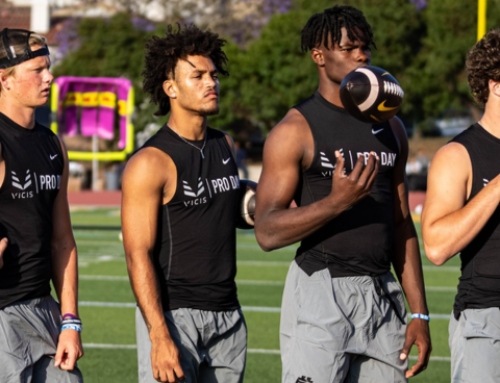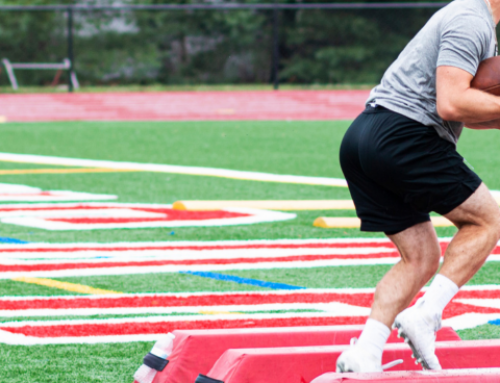3 Key Football Blocking Drills for Offensive Players
During a typical football play, only one offensive player gets to carry the ball. This means that the other 10 players on offense better block somebody, stat. Whether your squad is trying to protect the quarterback for a pass downfield or run block to stuff the ball down the defense’s throat, each offensive player has a specific set of blocking skills he needs to use. Here are the necessary drills to become a successful blocker at each position.
- Position: Offensive lineman
- Needs: Teamwork, communication, technique
- Try: Zone Stack Drill
In this drill, two offensive linemen go against two defensive players (defensive lineman with a linebacker behind). The defensive lineman positions himself in line with one of the shoulders of an offensive lineman.
At the snap, both offensive linemen attack the lone defensive lineman. The simulated play and the alignment of the defensive lineman will dictate what steps the offensive linemen take. One of the offensive linemen will then slide off the defensive lineman to block the oncoming linebacker.
For example, the center and right guard will prepare to block a defensive lineman who’s lined up on the outside shoulder of the guard. Both offensive linemen must attack the defensive lineman’s outside shoulder. If the linebacker crashes the line of scrimmage, he will be picked up by the center, but if the ‘backer goes to the outside, the guard will step up and stop him.
This is an ideal drill for coaches, because they can stand directly behind the offensive linemen and direct the attacking defense. This drill forces the linemen to communicate and react to the defensive movement. The offensive linemen will always block the defensive lineman first, but they must also keep their eyes on the linebacker.
- Position: Running backs
- Needs: Courage, quick thinking
- Try: Play Under Pressure (PUP)
The PUP Drill uses the whole playing field, pitting 11 players on offense against 11 on defense. The offense runs a passing play on each down, and certain linebackers blitz. The linebackers know every play is a pass, so they are exclusively focused on getting to the quarterback. Following the correct pass protection scheme, the running back must step up and take on the blitzing linebackers who have slipped past the offensive line.
Backs have two options: Slide and take out the defender’s knees in legal fashion, or try to block him upright. Coaches have less control over this drill because it moves so quickly, but it’s a better simulation of game situations.
- Position: Receivers
- Needs: Downfield blocking, footwork
- Try: Mirror Drill
The Mirror Drill is an excellent way to teach receivers the “stalk technique”—running downfield and blocking a defender in the open field. The receiver begins between two and 10 yards from the defensive back. He runs toward the defender, whose job is to avoid the receiver’s block by side stepping or swimming him. The receiver must mirror the defender’s lateral movements to prevent him from getting by. Receivers are rarely asked to drive defenders backwards, so the emphasis at the point of contact is keeping the receiver’s body between the defender and the ball carrier.
Get better this summer with more football drills from STACK.com.
Photo: elyriact.smugmug.com
RECOMMENDED FOR YOU
MOST POPULAR
3 Key Football Blocking Drills for Offensive Players
During a typical football play, only one offensive player gets to carry the ball. This means that the other 10 players on offense better block somebody, stat. Whether your squad is trying to protect the quarterback for a pass downfield or run block to stuff the ball down the defense’s throat, each offensive player has a specific set of blocking skills he needs to use. Here are the necessary drills to become a successful blocker at each position.
- Position: Offensive lineman
- Needs: Teamwork, communication, technique
- Try: Zone Stack Drill
In this drill, two offensive linemen go against two defensive players (defensive lineman with a linebacker behind). The defensive lineman positions himself in line with one of the shoulders of an offensive lineman.
At the snap, both offensive linemen attack the lone defensive lineman. The simulated play and the alignment of the defensive lineman will dictate what steps the offensive linemen take. One of the offensive linemen will then slide off the defensive lineman to block the oncoming linebacker.
For example, the center and right guard will prepare to block a defensive lineman who’s lined up on the outside shoulder of the guard. Both offensive linemen must attack the defensive lineman’s outside shoulder. If the linebacker crashes the line of scrimmage, he will be picked up by the center, but if the ‘backer goes to the outside, the guard will step up and stop him.
This is an ideal drill for coaches, because they can stand directly behind the offensive linemen and direct the attacking defense. This drill forces the linemen to communicate and react to the defensive movement. The offensive linemen will always block the defensive lineman first, but they must also keep their eyes on the linebacker.
- Position: Running backs
- Needs: Courage, quick thinking
- Try: Play Under Pressure (PUP)
The PUP Drill uses the whole playing field, pitting 11 players on offense against 11 on defense. The offense runs a passing play on each down, and certain linebackers blitz. The linebackers know every play is a pass, so they are exclusively focused on getting to the quarterback. Following the correct pass protection scheme, the running back must step up and take on the blitzing linebackers who have slipped past the offensive line.
Backs have two options: Slide and take out the defender’s knees in legal fashion, or try to block him upright. Coaches have less control over this drill because it moves so quickly, but it’s a better simulation of game situations.
- Position: Receivers
- Needs: Downfield blocking, footwork
- Try: Mirror Drill
The Mirror Drill is an excellent way to teach receivers the “stalk technique”—running downfield and blocking a defender in the open field. The receiver begins between two and 10 yards from the defensive back. He runs toward the defender, whose job is to avoid the receiver’s block by side stepping or swimming him. The receiver must mirror the defender’s lateral movements to prevent him from getting by. Receivers are rarely asked to drive defenders backwards, so the emphasis at the point of contact is keeping the receiver’s body between the defender and the ball carrier.
Get better this summer with more football drills from STACK.com.
Photo: elyriact.smugmug.com











